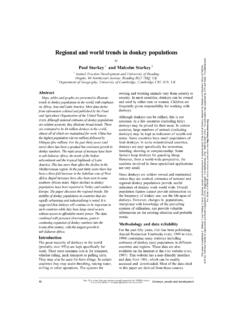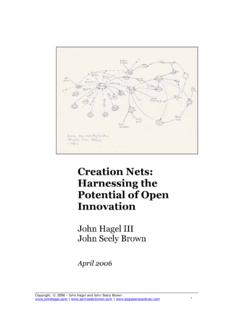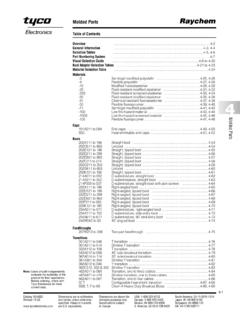Transcription of Harnessing guidelines for single donkey carts - ATNESA
1 Harnessing guidelines for single donkey carts Henk J DibbitsDepartment of Development Cooperation, Institute of Agricultural and EnvironmentalEngineering (IMAG-DLO), PO Box 43, Wageningen, The NetherlandsSummaryThe Harnessing guidelines for donkeys pulling a single donkey cart are based on practices fromEurope which are adapted to the situation in many African countries. The basic principles remainthe same, anatomy of the donkey and criteria for a donkey harness, but the concept is to make acomfortable harness from locally available materials. The most simple pulling device is opted for,the breast strap harness. Examples are given how to measure the size of the straps and how tomake the breast strap harness, keeping in mind the necessary animal comfort. Cheap saddles andbreaking devices are also described and a few examples of single donkey carts from Kenya andWest Africa are is a growing interest in how to use donkeys in rural transport and for agricultural some areas cattle died due to effects of droughts and cattle diseases, and farmers are looking foran alternative to ox-power.
2 In areas where donkeys are already used, their assistance in carryinggoods, rural transport and agricultural operations like plowing and weeding is very muchappreciated. Although donkeys are very clever and easy to train, there are some limitationscompared with oxen. They are lighter, their power is lower and the Harnessing system is morecomplicated. Some farmers who start using donkeys for pulling carts and implements, use a , yokes are not suitable for donkeys. They cause wounds and sores on the donkeys' necks,making donkeys stubborn and rendering them unusable for several widely used system of Harnessing two (or more) donkeys to a two-wheel cart in South Africacan cause distress to the animals. The weight of the dissel-boom is taken on the necks of thedonkeys and thin straps can cut into the flesh. This problem is generally avoided by using carts forsingle donkeys. On these the weight of the two shafts is taken by a broad saddle on the animal sback, which is more comfortable (Starkey, 1995).
3 These guidelines to harness donkeys are made for extension staff, harness makers, manufacturersof donkey carts and farmers in order to create more understanding about the Harnessing principlesfor donkeys and to provide information about cheap and simple Harnessing possibilities for pullingsingle donkey key issue is efficiency and donkey comfort. Traditional harnesses are minimal-cost designs,and any improvement is likely to involve extra cost. The benefits will depend upon the potentialfor exploiting the increase in of a donkeyThe structure of the body (anatomy) of a donkey is different from that of an ox. A donkey has nohump and there is little muscle tissue to form a cushion at the withers. Therefore a yoke does not fiton the neck of a donkey . Besides, a donkey has a thin skin and a yoke and the skeis (wooden sticksto separate the oxen) cause wounds and sores on the neck and can be harnessed with a breast strap harness which is the most simple harness for adonkey.
4 But looking at the breast of a donkey , it is narrower than that of a horse and it is slanting(Figure 1). When the donkey pulls, the breast strap tends to slip downwards, which has to beprevented by the neck strap. This is less of a problem when pulling carts (line of pull more or lesshorizontal) than when pulling implements. The breast strap should not be fitted too high, because62 Improving donkey utilisation and managementthen it will press against thewind pipe and choke the , also not too low. Thebreast strap should run acrossthe chest just above the point ofshoulder (Figure 2).Another possibility to harness adonkey is a collar harness(Figure 3). This harness has padslaying against the neck, just infront of the shoulder blades. Ithas many advantages, eg a largecontact surface (comfort) and nopressure on the wind pipe, but itis more complicated to makethan a breast strap harness and itis far more expensive. The mainadvantage of the collar harnessis its efficiency in transmittinghigh draft forces (plowing).
5 Inthis paper, no attention is givento the construction and use ofthe collar harness. The reasontherefore is that still much canbe done at low cost to improvethe cheap and widely usedbreaststrapharnessesinSouthern (this section is drawn fromBarwell and Ayre, 1982)The power output of a donkeydepends very much on theharnessing device. The harnesstransmits the power from thedonkey to the cart or (comfortable) harness a donkeyis able to develop more powerand becomes less fatigued. The importance of a good harness is not only the welfare of the donkeybut it is also the interest of the owner. A good harness makes it possible to do the same amount ofwork with fewer criteriaTo suit the donkey , the harness should: fit the physical characteristics of the donkey ; be designed in such a way that the donkey 's strong muscles are effectively utilized, and thatit can put its full weight into work; not cause discomfort or injury to the donkey .
6 This requires:- that the harness should fit well on the donkey and that it is smoothly-shaped or padded sothat the loads imposed on the donkey 's body are spread over a large area, with the avoidanceReader for ATNESA workshop, 5 9 May 1997, Debre Zeit, Ethiopia63 Harnessing guidelines for single donkey cartsFigure 1: Names of the parts of a donkeySource: after Ellis, Ellis and Claxton, 1980 Figure 2: Breast strap positions. Source: Ellis et al, 1980of excessive friction in one place;- that pressure on critical areas of the donkey 's body is avoided;- that the harness should be securely fitted to the donkey to prevent it from moving aboutand banging against the animal during normal work and manoeuvring;- be easily adjustable to fit the donkey at all times. A standard harness should fit donkeys ofvarious sizes and if it is made for a particular donkey , even that donkey can grow thicker orthinner depending on the amount of work it does and the amount of feed are made with straps and suit the characteristics of the implementsto be drawn by donkeys the harness should: have suitable attachment points for the range of implements to be used; have sufficient 'flexibility' to allow manoeuvring of implements, for example:turning of agricultural implements at the end of the field;reversing of wheeled implements, including carts .
7 This requires that the donkey should beable to push backwards against the cart; be designed in such a way that the cart can not run forward into the back of the donkey andallows the donkey to apply a braking force in a comfortable and efficient way. Ideally cartsshould be fitted with brakes, but frequently this is not the case. Even when brakes are fitted,the harness should be designed such that the cart is prevented from running forward into thedonkey(s) in the event of brake failure or driver error; be designed so that the downward loads imposed on the animal are supported in an efficientway. Donkeys, when drawing a two-wheeled cart, act as the third point of support for thecart and therefore carry a proportion of the load. Even when the cart is perfectly balancedabout the wheels when stationary, loads will be imposed on the animals under dynamicconditions (eg traversing a bumpy track, accelerating and braking). Ideally these loadsshould be supported on the animals back and not on the neck; be designed in such a way that tipping backwards of two-wheeled carts can be avoided,without causing injury to the donkeys.
8 Have some flexibility in relation to the implement/harness system so that, when travellingon uneven ground, there is allowance for vertical movement of the animal relative to theimplement. If the system is rigid the animal will experience considerable criteriaThe harness should be manufactured by using locally available materials and skills. Wherever animproved harness is being introduced to replace a traditional design, it is desirable that localcraftsmen are capable of manufacturing harness should be durable and easy to criteriaThe cost of a harness should be appropriate to the circumstances of local users. Traditionalharnesses are 'minimal-cost' designs, and any improvements are likely to involve extra cost. Thewillingness of users to invest in more efficient harnesses will depend on their ability to pay the costfor the benefits which they gain from increased working efficiency of their animals. Thesebenefits will depend upon the potential for exploiting this increase in donkey utilisation and managementHenk J DibbitsFigure 3: Plowing and weeding with donkeys using collar harnessesParts of a donkey harness for pulling a single donkey cartFunctionsThe functions of a harness for pulling a single donkey cart can be summarized as follows: controlling the donkey transmitting the power from the donkey to the implement or cart keeping a cart in balance braking and bitThe bridle and bit are meant to control the donkey .
9 They are of great help during the training of thedonkey and by driving. Well trained donkeys can do without a bit and some even without a donkey owners guide and control the donkey (s) by oral commands. Instead of abridle a halter can be used. However, when one works with donkeys for the first time, it isadvisable to use a bridle and bit to ease bit must be buckled to the bridle by its rings. For each donkey the cheek straps of the bridleshould be adjusted so that the bit fits in the corners of the mouth and the donkey can not move itwith its tongue. The throat lash is done tight enough to prevent the bridle from slipping off butloose enough to allow the donkey to flex. The noseband keeps the bridle close against the head,without being uncomfortably tight. Allow enough room to insert at least one finger between thelower jaw and the noseband (Ellis et al, 1980).ReinsThe reins connect the donkey s mouth bridle to the driver s hands. The reins pass through the reinterrets on the neck strap (if available) and they are fixed to the rings of the bit (or to both sides ofthe halter if a bit is lacking).
10 The reins can be made out of a (nylon) rope or narrow leather of a donkey harness for pulling a single donkey cartFunctionsThe functions of a harness for pulling a single donkey cart can be summarized as follows: controlling the donkey transmitting the power from the donkey to the implement or cart keeping a cart in balance braking and bitThe bridle and bit are meant to control the donkey . They are of great help during the training of thedonkey and by driving. Well trained donkeys can do without a bit and some even without a donkey owners guide and control the donkey (s) by oral commands. Instead of abridle a halter can be used. However, when one works with donkeys for the first time, it isadvisable to use a bridle and bit to ease bit must be buckled to the bridle by its rings. For each donkey the cheek straps of the bridleshould be adjusted so that the bit fits in the corners of the mouth and the donkey can not move itwith its tongue.







